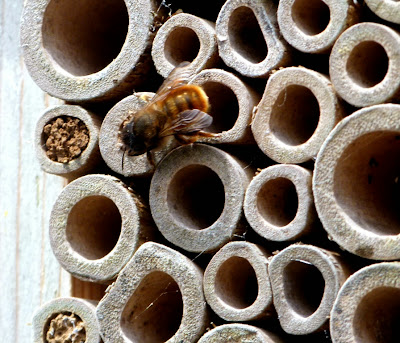I noticed the red mason bees mating (again) on the wall at the front of our house earlier in the year. This is a link to the red mason bees mating last year http://urbanwildlifejottings.blogspot.co.uk/2011/04/red-mason-bees-mating.html
I first noticed red mason bees visiting the bee hotel on 26th May this year. The flight period for this small bee is late March to early June. It may be a bit later this year due to the poor weather earlier in the year.
Since then I have enjoyed the coming and going of several bees who have used the bee hotel to nest.
Normally, mason bees will nest up high in small gaps and holes in bricks and buildings, which is where the 'mason' in their name comes from.
The female makes a series of cells with soft soil and packs each cell with a paste made of pollen and nectar, which will feed and nourish the single larvae in each cell. The female does not have pollen baskets, but carries it on the underside of her body.
These are fascinating bees to watch and I would definately recommend anyone to have a go. At the same time you will also be helping bees. Red mason bees are particularly useful in that they pollinate fruit trees such as apple.
One day I watched two bees that behaved quite oddly. It was almost if they had forgotten which hole they were nesting in.
One bee wouild lay in wait and chase of this other bee as it landed. There are cuckoo bee species that lay their eggs in other bees nests, but these both looked to be red mason bees.
To date, nine of the nesting tubes have been used and pluged with mud. Two others still have bee vistors
My home made bee home around the front of the house is also being used by red mason bees.
There are many other species of solitary bee that visit our garden, so hopefully the bee hotel will attact other bees.





























